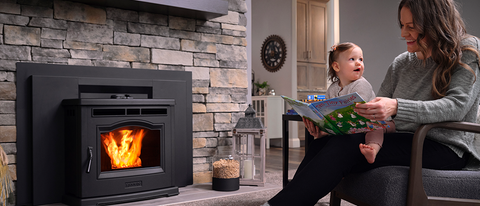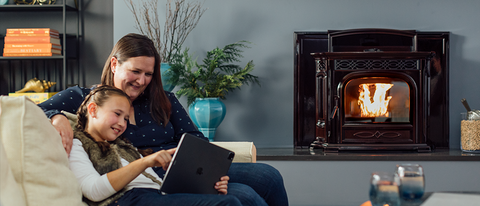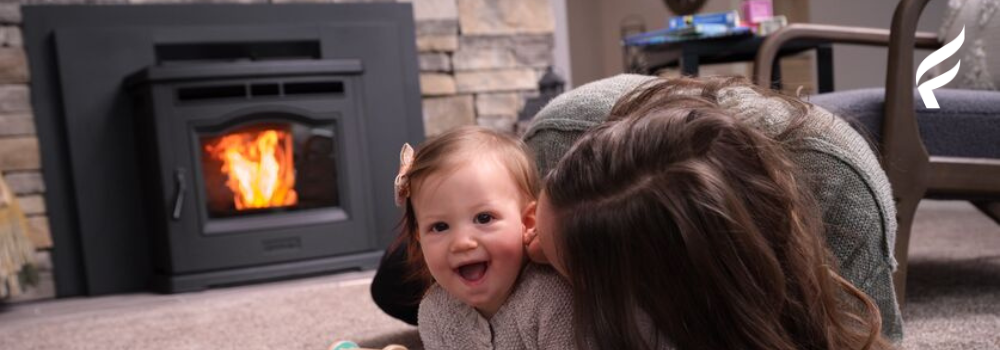A fire element cultivates a cozy and inviting atmosphere in a living space. But with a traditional wood-burning fireplace in the wintertime, chances are it can get drafty and cold inside. That’s where pellet inserts come in! Pellet inserts are the solution to your inefficient, drafty traditional wood fireplace.
In this blog, we will explore what a pellet insert is, the differences between traditional wood fireplaces and pellet inserts and considerations for adding a pellet insert to your home.
What is a Pellet Insert?
A pellet fireplace insert is a heating appliance designed to be installed inside an existing fireplace. A pellet insert is comparable to a pellet stove—it has a hopper that holds the pellets, an auger that feeds the pellets into the combustion chamber and a fan that blows warm air into the room to distribute the heat. The biggest difference is a pellet insert slides into a fireplace space and is vented through a chimney, as opposed to a freestanding unit that is vented through wall or ceiling.
These heating units are known to boast both high efficiency and heat output, extracting its heat from a renewable resource—you guessed it— wood pellets. From creation to use, pellet fuel centers around sustainable practices, producing fewer greenhouse gasses than fossil fuel systems.
How is a Pellet Insert Different from a Fireplace?
A pellet insert and a wood-burning fireplace are designed to provide warmth, ambiance and comfort in a home. Yet, they differ in many ways when it comes to considerations that matter most: efficiency, heating costs and ease of use.
Efficiency
Radiant heat is produced by the fire in a wood fireplace and is absorbed by people and objects in the room. This type of heat is especially noticeable when sitting close to the fireplace, as it provides direct warmth. While you might feel heat close to the fire, the downfall is that it doesn’t disperse well throughout a home. Furthermore, traditional wood fireplaces burn in an open firebox so most of the heat is emitted up the chimney, rather than into your living space.
On the other hand, pellet inserts keep the heat you pay for within your home. A pellet insert produces convective heat. Convective heat is produced as the stove draws in cool air from the room. The stove heats the air by passing it over the hot pellets and then the blower circulates the warm air throughout the room. This helps warm the entire room (or space) rather than just the immediate area around the stove. An insert uses combustion technology to burn pellets at a high temperature and extract maximum heat from them, providing up to 24 hours of heat with one hopper full of pellets. So, for less fuel, insert users can enjoy a fire with a longer burn time.
Heating Costs
As mentioned, pellet inserts produce more heat with less fuel, thus reducing heating costs. In fact, depending on the size of the stove and your home, a pellet insert can heat up to 2,500 square feet for as little as $5 per day. Traditional wood fireplaces lose much of their heat up the chimney, thus burning copious amounts of wood fuel with little heat output into your home.
Ease of Use
Wood-burning fireplaces can also be messy and require more maintenance to keep them clean and safe than pellet inserts. Traditional wood fireplaces need intensive cleaning after each fire and require at least 12 hours for everything to cool before sweeping away any remaining ash and debris. That means you’ll have more work, and be without heat for those 12 hours.
Harman pellet inserts not only require less maintenance and cleaning. Moreover, Harman pellet inserts can safely stay on during routine cleaning, such as scraping the burn pot, so you can enjoy true 24/7 heat.
What Option is Best For Your Home?
Overall, pellet inserts are a more efficient, cost-effective and user-friendly heating option than traditional wood-burning fireplaces. Pellet inserts also burn cleaner, producing fewer emissions and pollutants than a conventional fireplace and require less fuel to burn. For these reasons, a pellet insert is a superior choice for heating a home.
Considerations for Adding a Pellet Insert to Your Home

Before you invest in a pellet insert, it’s important to consider all angles. For this reason, we’ve listed some answers to consumers most commonly asked questions.
Consideration 1: Does a Fireplace Insert Need a Chimney?
When repurposing an existing wood fireplace, a pellet insert is vented using an adapter and liner in the existing chimney to direct combustion byproducts out of your home. Otherwise, if you are not repurposing an existing fireplace and instead are building a new hearth, you can install a new pellet insert and vent it through an external wall or ceiling without an insert.
If you are placing the pellet insert into an existing wood fireplace, the physical size (measurement) of the firebox and surround will need to be carefully measured to assure proper fit. In some cases, a surround extension may be needed to cover a larger fireplace opening. For expert guidance, consult a professional installer to ensure the chimney is in working order and proper venting is added to the chimney before installing an insert.
Consideration 2: How Much Does It Cost to Put in a Fireplace Insert?
The cost of installing an insert can vary widely depending on a number of factors, such as:
- The make and model of the insert: Different brands come with various technologies and standard features.
- Size of the existing fireplace: If you have a larger fireplace, you may need a surround extension to cover the opening, which could raise the price.
- Chimney condition: Depending on the condition of the chimney, you may need to repair or re-line it prior to installing an insert.
- Installation labor costs: You will need to pay for the labor costs incurred while installing your insert, along with any chimney repairs needed.
- Your location: Installation costs vary across the country.
While there’s an initial financial investment involved, there are many factors that make it a worthwhile purchase. The cost for pellets varies little from year-to-year as compared to other fuel types.
Additionally, a pellet insert can help stabilize heating costs from your energy bill by improving your home’s heating efficiency. For these reasons, you can enjoy the financial benefits for years to come.
Consideration 3: How is a Fireplace Insert Installed?
Installing a fireplace insert involves several steps, shown below, and it's typically a job best left to a professional installer or certified technician. They can ensure the insert and venting are safely installed.
- Choose the right insert: There are several types of fireplace inserts available on the market, and you need to select the one that suits your existing fireplace's size, fuel type and venting requirements. The cost of a pellet insert ranges from $4,000 to $6,000.
- Prepare the fireplace: Before installing the fireplace insert, an installer will clean and prepare your existing fireplace. Then, they will inspect the chimney and flue to ensure they are in working condition and meet the venting requirements for the new insert.
- Connect the venting system: For pellet-burning units, a professional will install a venting system consisting of a vent pipe that connects to the insert and extends up the chimney or through an exterior wall.
- Install the insert: The insert is then placed inside the existing fireplace. The installation process varies depending on the insert, make and model. Generally, the insert is secured with brackets and connected to the chimney flue.
- Test the unit: Ensure it works correctly and the venting system functions properly.
Looking for Pellet Insert Options? 
Don’t live through a drafty winter again! Here’s why you should upgrade your fireplace with a Harman pellet insert:
- Installation is a snap! Completed in as little as one day, a beautiful Harman pellet insert fits into your current fireplace opening.
- It’s sealed with an airtight system and efficiently vented directly out an external wall, ceiling or up your existing chimney so there are no drafts.
- With our exclusive EASY Touch Control and wireless room sensor you set the temperature for the space in your home and the stove controls it accurately, 24/7, within one degree. Pellet Pro and Exhaust Sensing Probe technologies are top-of-the-line systems, offered only by Harman, burning any grade of pellet fuel with high efficiency and low maintenance.
- Our pellet inserts require up to 50% less maintenance than any other pellet inserts available on the market thanks to the air wash and slide-out track systems.
Popular Harman Inserts
The Harman Accentra52i-TC is the best-selling pellet insert in the nation, saving both time and money. Enhanced with our exclusive Easy Touch Control and illuminated glass hopper lid, the Accentra52i-TC includes our legendary Pellet Pro Technology, ESP technology, flame reactive mirrored glass and much more.
Newly introduced to Harman’s line of pellet products, the P42i-TC pellet insert includes the Harman features you know and love, plus premium efficiencies that bridge beauty and functionality.
Now’s the Time to Buy
It’s no secret that you can burn smarter with a pellet fireplace insert. So, if you’re looking for steady, warm, and uber-comforting heat that is cost effective and eco-friendly, now is the perfect time to invest in a Harman pellet insert!
For more information, connect with a local authorized Harman dealer.


